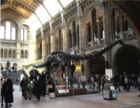Natural History Museum wins best-campaign award

The central hall at the Natural History Museum has a capacity of 60 t of carbon dioxide; the objective was to save four times that.
Every one of the 850 staff of the Natural History Museum was involved in its ‘100 Days’ campaign. The central exhibition hall at the Natural History museum was used as the measure for its carbon-saving campaign. It has a capacity of 60 t of carbon dioxide, and it was calculated that the museum needed to save four central-halls-worth of carbon dioxide to meet its target of 240 t. The main aim of the campaign was to involve all 850 staff and to provide a clear and visible image to report against monitored progress. A central-hall gauge was the focal of a dedicated ‘100 Days’ intranet site. A dedicated e-mail address for the campaign was also set up so that staff could directly e-mail to the 100-days team queries, comments and competition responses. To involve staff with no access to such avenues for raising awareness, particularly public-facing roles, a new communication channel was set up in a television screen at the staff work entrance. It showed different presentations on a loop each week, highlighting campaigns for the week, competitions, tips and progress so far. The energy used by the screen was accounted for in the target reductions. The ‘100 Days’ was also promoted to staff in person in meet-and-greet sessions. The team set up tables in two canteen areas displaying information of energy-saving in the home, demonstrations of the Wattson device for monitoring electricity consumption in the home and the ‘Act on CO2’ carbon-footprint Internet site. 102 staff took home and energy-efficient light bulb in return for filling in a home energy survey. There were five main approaches to reducing carbon emissions. To try to get as near to zero energy use overnight as possible, attention was directed at lights, computers, photocopiers and fans. Security teams monitored items left on, and this information was used to name and shame the worst performers by room. Available meter readings indicated that at least 75 t was saved by early December. Recycling involved translating the tonnages of waste glass, paper and cardboard recycled and purchases of recycled paper. In September the benefits amounted to 13.6 t of carbon dioxide. The recently opened CHP plant at the museum was the subject of an open day. The aim was to demonstrate the advantages of CHP and how it has significantly reduced the carbon footprint of the museum. Staff were also able to download a program to their PCs to adjust energy-saving features so that screens and PCs were only on for five to 10 minutes if unused. A calorie-counter spreadsheet was also devised to show how many calories a person would burn for each flight of stairs taken to discourage the use of lifts during the campaign.


